What exactly is tui-na pet massage? Tui-na (pronounced “twee-nah”) is an ancient therapy crafted for your pet’s well-being. It is a holistic blend of acupressure, massage, and chiropractic care that can work in conjunction with conventional medicine.
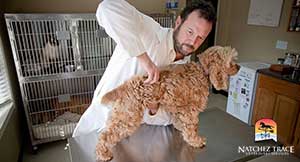 Tui-na integrates with acupuncture, Eastern herbal medicine, food therapy, and exercise/lifestyle programs, enhancing its therapeutic impact.
Tui-na integrates with acupuncture, Eastern herbal medicine, food therapy, and exercise/lifestyle programs, enhancing its therapeutic impact.
While veterinary experts excel in Tui-na techniques, you can bring these benefits to your pets at home. Tui-na helps alleviate pain and support recovery with simple, safe, and practical techniques for home treatments.
Here, we’ll show you how to incorporate Tui-na into your pet’s routine to enhance their overall health and happiness.
Please don’t be overwhelmed with the information. We’ll let you know which techniques are the most appropriate for your pet’s health.
We are here to guide you every step of the way on your journey into holistic pet wellness!
The Different Tui-Na Pet Massage Techniques
Tui-na was developed by Dr. Han Ping, a Tui-na/An-mo professor at Beijing University of Traditional Chinese Medicine.
Initially designed for humans, the techniques seamlessly benefit animals in veterinary medicine.
As we dive into Tui-na, we focus on gentle hand techniques to ensure the best results—using soft, fluid movements with balance, duration, and light pressure.
Mo-fa (Touching Skin and Muscle)
Mo-Fa (pronounced “moe-fah”) involves a soothing, rhythmic motion using the palms of the hands and fingers with light to moderate pressure.
This technique engages nervous system reflexes, working through the skin and superficial connective tissues to restore circulation and promote homeostatic reactions in internal organs.
Now, let’s explore simple instructions on how to perform Mo-Fa and discover the range of benefits it brings to your pet.
Mo-Fa Massage Instructions:
- Prepare a Relaxing Space: Choose a quiet and comfortable area to create a calming environment for your pet.
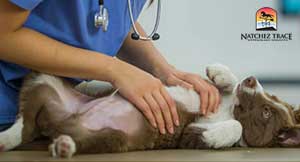
- Use Gentle Palms and Fingers: Employ the palms of your hands and fingers to apply light to moderate pressure during the massage.
- Master the Spiral Motion: Rub your pet’s skin using a rhythmic spiral motion. Ensure your hands move in a circular pattern for a soothing effect.
- Tailor to Weak or Geriatric Animals: Adjust the pressure and duration of the massage for weak or geriatric animals, providing a gentle and nurturing experience.
- Address Specific Concerns: Focus on areas related to specific health concerns, such as constipation, diarrhea, or food retention, using Mo-Fa to alleviate the issues.
Benefits of Mo-Fa Massage:
- Relaxation: Induces a sense of calm and relaxation for your pet.
- Circulation Restoration: Promotes circulation, aiding in restoring optimal blood flow.
- Specific Issue Relief: Addresses concerns like constipation, diarrhea, and food retention.
- Ideal for Weak and Geriatric Animals: Particularly useful for weak or geriatric animals, offering them tailored care and support.
Incorporate Mo-Fa into your routine to give your pet a delightful and beneficial massage that will enhance their overall well-being.
Rou-fa (Rotary Kneading)
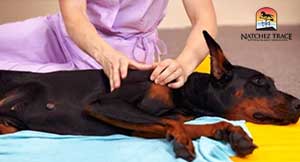 Rou-Fa (pronounced “roh-fah”) involves a gentle rotational motion using the ball of the fingers and the heel of the hand.
Rou-Fa (pronounced “roh-fah”) involves a gentle rotational motion using the ball of the fingers and the heel of the hand.
Now, let’s explore step-by-step instructions on performing Rou-Fa at home and unravel its benefits for your pet.
Watch this video so you can do this to easy massage to your pet:
Rou-Fa Massage Instructions:
- Select a Tranquil Setting: Choose a serene and peaceful environment to create an ideal space for your pet’s massage.
- Employ a Gentle Rotational Motion: Use the ball of your fingers and the heel of your hand to perform a gentle rotational motion during the massage.
Benefits of Rou-Fa Massage:
- Pain Relief: Relieves pain in your pet, fostering a sense of comfort and well-being.
- Elimination of Food Retention: Aids in eliminating food retention, promoting digestive health.
Integrate Rou-Fa into your pet care routine, and witness the positive impact on their physical and emotional well-being.
Ca-fa (Rubbing)
Ca-Fa involves applying rapid, linear, and moderately forceful movements of the palms, providing a warming stimulation to the skin and underlying tissues.
Watch this tutorial video, and we’ll lead you through the application of rapid, linear, and moderately forceful movements using the palms, ensuring your dog’s comfort and safety throughout:
Now, let’s explore step-by-step instructions for performing Ca-Fa and unveil its multitude of benefits for your pet.
Ca-Fa Massage Instructions:
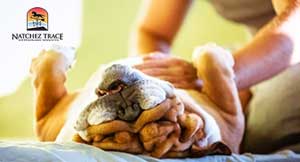 Create a Cozy Atmosphere: Set the stage by choosing a warm and comfortable environment, ensuring your pet feels at ease.
Create a Cozy Atmosphere: Set the stage by choosing a warm and comfortable environment, ensuring your pet feels at ease.- Apply Rapid, Linear Movements: Use the palms of your hands to apply rapid, linear, and moderately forceful movements while firmly touching the skin.
- Focus on Warming Stimulation: Concentrate on softly warming the skin and underlying tissues, enhancing your pet’s overall comfort.
Benefits of Ca-Fa Massage:
- Soft Warming Stimulation: Provides a gentle and warming touch, creating a soothing experience for your pet.
- Geriatric Pets: Tailored for senior animals, offering warmth to those feeling cold.
- Comprehensive Circulation Enhancement: Combines effectively with Cuo-Fa to improve peripheral circulation, promoting overall well-being.
Integrate Ca-Fa into your pet care routine and witness its comforting and therapeutic impact on your pet’s physical and emotional health.
Tui-fa (Pushing)
Tui-Fa involves a forceful one-directional movement using the finger, thumb, palm, or elbow, following the lines of major muscles, tendons, and ligaments.
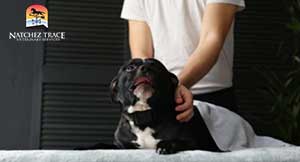 Tui-Fa can be performed bilaterally along the epaxial muscle groups of the spine, which is especially useful for animals with intervertebral disk disease (IVDD).
Tui-Fa can be performed bilaterally along the epaxial muscle groups of the spine, which is especially useful for animals with intervertebral disk disease (IVDD).
The technique starts with light pushing and progresses to deeper pressure based on the animal’s tissues and comfort.
It shares similarities with myofascial release techniques practiced in other conventional bodywork methods.
Now, let’s explore step-by-step instructions on performing Tui-Fa and discover its benefits to your pet.
Tui-Fa Massage Instructions:
- Establish a Calm Environment: Choose a quiet and calming space to create an ideal atmosphere for your pet’s massage.
- Select Finger, Thumb, or Palm: Decide whether to use your finger, thumb, or palm based on your pet’s size, the area being massaged, and your pet’s comfort.
- Follow Muscle, Tendon, and Ligament Lines: Perform a gentle yet forceful one-directional movement, following the lines of major muscles, tendons, and ligaments in a smooth, gliding motion.
- Focus on Epaxial Muscle Groups for IVDD: Bilaterally, massage along the epaxial muscle groups of the spine is especially beneficial for animals with intervertebral disk disease (IVDD).
- Gradually Increase Pressure: Begin with light pushing and gradually increase pressure as the tissues and your pet allow. Ensure a smooth progression to deeper pressure.
- Alternate with An-fa for Comprehensive Care: Alternate Tui-Fa with An-fa for a comprehensive approach, providing balanced care for your pet.
Benefits of Tui-Fa Massage:
- Muscle and Tendon Relaxation: Effectively relaxes muscles and tendons, promoting a sense of ease and comfort.
- Treatment for IVDD, Bi Syndrome, and Spondylosis: Particularly useful for conditions like intervertebral disk disease (IVDD), Bi syndrome, and spondylosis.
- Softening Connective Tissues: One of the most essential techniques to soften connective tissues, ensuring flexibility and mobility.
- Myofascial Release Similarities: Shares similarities with myofascial release techniques in conventional bodywork, providing a familiar approach to pet massage.
Integrate Tui-Fa into your pet care routine and witness the transformative impact on their muscular and tissue health, fostering a harmonious balance in their well-being.
An-fa (Pressing)
An-Fa involves applying light pressure to an area using the thumb and/or index finger, gradually increasing pressure.
In the video below, learn how to give your dog a soothing and relaxing massage at home using the An-Fa method:
It also works well in conjunction with or following Rou-Fa.
Now, let’s explore step-by-step instructions on performing An-Fa and discover its benefits to your pet’s overall well-being.
An-Fa Massage Instructions:
 Set a Tranquil Scene: Begin in a serene and calming environment, creating an ideal space for your pet’s relaxation.
Set a Tranquil Scene: Begin in a serene and calming environment, creating an ideal space for your pet’s relaxation.- Use Thumb and/or Index Finger: Employ the thumb and/or index finger for the massage, choosing the digit that feels most comfortable for you and your pet.
- Start with Light Pressure: Initiate the massage with light pressure, allowing your pet to acclimate to the touch.
- Gradually Increase Pressure: Progressively apply deeper pressure as your pet becomes accustomed to the massage, ensuring a gentle and gradual transition.
- Coordinate with Rou-Fa: You can perform An-Fa on its own or coordinate it with Rou-Fa, creating a harmonious combination for your pet’s well-being.
Benefits of An-Fa Massage:
- Single Finger Precision: Utilizes the precision of a single finger, allowing targeted and focused attention to specific areas.
- Enhanced with Rou-Fa Combination: Coordinates seamlessly with Rou-Fa, creating a synergistic approach for comprehensive care.
Integrate An-Fa into your pet care routine. Offering a gentle touch that promotes the harmonization of Qi and Blood, An-Fa will contribute to your pet’s overall vitality and comfort.
Ba-Sheng-Fa (Stretching)
Ba-Sheng-Fa involves gently pulling and applying traction to the muscles and joints of the limbs. Bang-Sheng Fa also includes applying traction to the tail, performed rhythmically for 10 repetitions each time.
In the video below, we demonstrate effective techniques for applying traction to your dog’s muscles, particularly focusing on geriatric pets:
Now, let’s explore step-by-step instructions on performing Ba-Sheng-Fa and unlock its benefits to your pet’s limb mobility.
Ba-Sheng-Fa Stretching Instructions:
 Create a Calm Environment: Begin in a peaceful, stress-free environment, ensuring your pet feels relaxed and comfortable.
Create a Calm Environment: Begin in a peaceful, stress-free environment, ensuring your pet feels relaxed and comfortable.- Gentle Limb Traction: Gently pull and apply traction to the muscles and joints of your pet’s limbs. Use a gentle touch to avoid any discomfort.
- Include Tail Traction: Extend the technique to include traction on the tail, applying gentle and rhythmic pulls.
- Perform 10 Repetitions: Aim for 10 repetitions each time you perform Ba-Sheng-Fa, maintaining a consistent and rhythmic pace.
- Strive for Rhythmic Execution: Strive to perform the stretching technique rhythmically, as this enhances the effectiveness of the treatment.
Benefits of Ba-Sheng-Fa Stretching:
- Regulation of Channels: Effectively regulates the Channels in your pet’s body, ensuring a harmonious energy flow.
- Mobilization of Joints: Facilitates the mobilization of joints, promoting flexibility and range of motion.
- Restoration of Anatomic Position: Works to restore the normal anatomic position of joints, tendons, and ligaments in the pelvic limbs.
- Tail Traction for Comprehensive Care: Includes tail traction to ensure comprehensive care for the entire pelvic region.
Integrate Ba-Sheng-Fa into your pet care routine, offering gentle stretching that promotes limb mobility, flexibility, and overall well-being.
Dou-Fa (Shaking)
Dou-Fa involves gently shaking or vibrating each limb with an up-down motion, using both hands while fully supporting the limb.
Now, let’s examine step-by-step instructions for performing Dou-Fa and discover its benefits for your pet’s limb health and overall wellness.
Watch this video of Dr. Becki showing how this technique can help your pet feel relaxed and comfortable. The Dou Fa technique is perfect for creating a calming experience for your pet:
Dou-Fa Shaking Instructions:
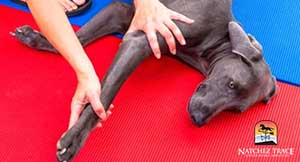 Establish a Calm Setting: Begin in a calm and quiet environment, ensuring your pet feels secure and relaxed.
Establish a Calm Setting: Begin in a calm and quiet environment, ensuring your pet feels secure and relaxed.- Fully Support the Limb: While performing Dou-Fa, fully support the limb to provide stability and comfort to your pet.
- Gentle Up-Down Motion: Use both hands to apply a gentle up-down shaking or vibrating motion to each limb. Ensure the movement is soothing and rhythmic.
- Extend to Each Limb: Systematically apply Dou-Fa to each limb, providing comprehensive care for your pet’s overall limb health.
Benefits of Dou-Fa Shaking:
- Smooth Joints: Works to smooth joints, enhancing flexibility and contributing to overall joint health.
- Soothing Vibrational Therapy: The gentle shaking motion serves as a form of soothing vibrational therapy for your pet.
- Comprehensive Limb Care: Extending Dou-Fa to each limb ensures comprehensive care for your pet’s entire body.
Integrate Dou-Fa into your pet’s care routine. It provides a gentle and rhythmic limb-shaking experience that contributes to their overall limb health and well-being.
Cuo-Fa (Kneading)
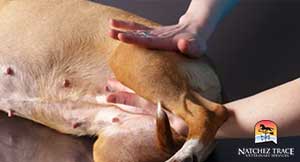 Cuo-Fa involves rapid kneading movements on each limb, utilizing the palms of both hands in a back-and-forth and up-and-down motion. The force applied should be equal in both hands, with rapid kneading and slow movement along the limb.
Cuo-Fa involves rapid kneading movements on each limb, utilizing the palms of both hands in a back-and-forth and up-and-down motion. The force applied should be equal in both hands, with rapid kneading and slow movement along the limb.
Cou-Fa also works great on the neck, chest, under the ribcage, abdomen, and waist.
Typically used at the end of a Tui-na treatment, Cuo-Fa offers a comprehensive and harmonizing touch to conclude the session.
Now, let’s explore step-by-step instructions for performing Cuo-Fa and understand its benefits for your pet’s overall well-being.
Cuo-Fa Kneading Instructions:
- Ensure a Calm Environment: Begin in a calm and quiet environment, setting the stage for a soothing Cuo-Fa experience.
- Equal Force in Both Hands: Maintain equal force in both hands during the rapid kneading movements to ensure balance and comfort for your pet.
- Rapid Kneading Movements: Utilize the palms of both hands to perform rapid kneading movements on each limb, moving back and forth and up and down.
- Slow Limb Movement: While the kneading is rapid, ensure the movement up and down the limb is slow, providing a nuanced and calming touch.
- Versatility Across Body Regions: Extend Cuo-Fa to various body regions, including the neck, chest, under the rib cage, abdomen, and waist, to ensure comprehensive care.
Benefits of Cuo-Fa Kneading:
- Channel Regulation: Effectively regulates the Channels, promoting a balanced and harmonious energy flow throughout the body.
- Qi and Blood Movement: Facilitates the movement of Qi and Blood, contributing to overall vitality and well-being.
- Versatile Application: The versatility of Cuo-Fa allows its application to multiple body regions, ensuring thorough care for your pet.
- Culmination of Tui-na Treatment: Typically used at the end of a Tui-na treatment, Cuo-Fa is a harmonizing touch to conclude the session.
Integrate Cuo-Fa into your pet care routine, providing a rhythmic and versatile kneading experience that contributes to their overall limb health and energy balance.
Nie-Fa (Pinching)
Nie-Fa involves using your fingers to pinch and squeeze the skin and epaxial muscles along your pet’s vertebral column..
Now, let’s explore step-by-step instructions on performing Nie-Fa and uncover its benefits to your pet.
Nie-Fa Pinching Instructions:
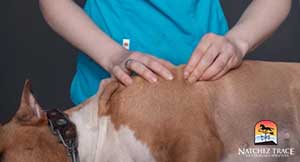 Create a Calm Atmosphere: Start in a calm and peaceful environment, ensuring your pet feels at ease and relaxed.
Create a Calm Atmosphere: Start in a calm and peaceful environment, ensuring your pet feels at ease and relaxed.- Gentle Pinching with Fingers: Use your fingers to gently pinch and squeeze the skin and epaxial muscles along the vertebral column. Ensure the pressure is gentle and comfortable for your pet.
- Focus on Vertebral Column: Concentrate on regulating the vertebral column, applying Nie-Fa with mindful attention to this area.
Benefits of Nie-Fa Pinching:
- Blood and Qi Invigoration: Effectively invigorates the Blood and Qi, promoting a harmonious energy flow in your pet’s body.
- Spleen and Stomach Regulation: Plays a role in regulating the Spleen and Stomach, contributing to digestive well-being.
- Appetite Stimulation: Stimulates the appetite, making it beneficial for pets with reduced interest in food.
- Vertebral Column Regulation: Focuses on the regulation of the vertebral column, providing targeted care to this area.
Integrate Nie-Fa into your pet care routine. Offering a gentle pinching touch that regulates vital aspects of their health and provides a comforting and invigorating experience, it will help your pet stay healthy.
Tips for Tui-Na Success
When you apply these techniques to care for your beloved pets, you harness potent tools to enhance their well-being through the art of Tui-na.
- Start Slowly and Gently: Begin each treatment gently and slowly. Avoiding excessive force is crucial; maintaining consistent pressure ensures optimal effectiveness.
 For Geriatric or Weak Pets: If your pet is geriatric, weak, or debilitated, exercise caution. Vigorous or prolonged treatments might further weaken them, so a gentle approach is essential.
For Geriatric or Weak Pets: If your pet is geriatric, weak, or debilitated, exercise caution. Vigorous or prolonged treatments might further weaken them, so a gentle approach is essential.- Session Length: Tui-na sessions can vary from 10 minutes to one hour, offering flexibility based on your pet’s individual needs.
- Which Techniques to Use: Don’t overwhelm yourself with too many techniques. We’ll let you know which techniques will help your pet the most, and you can move forward from there.
- Be Consistent: Consistency is crucial. Ideally, you should perform Tui-na treatments daily or at least three to five times per week. A follow-up visit after one week allows you to demonstrate the assigned techniques, ensure proper execution, and address any concerns.
- Wait 30 Minutes After Feeding: Maintain digestive health by waiting 30 minutes after a meal before performing a Tui-na treatment. This interval supports proper digestion by allowing normal blood flow to the bowel. As you integrate these Tui-na tips into your caregiving routine, prioritize the comfort and health of your cherished animal companion.
- For Acupuncture Patients: For optimal results, perform Tui-na treatments before acupuncture, massaging the area both before and after needle placement.
- Additional Support: Supplement Tui-na techniques with oral Eastern herbal medicine, food therapy, acupuncture, herbal liniments, salves, sprays, and patches as needed for a comprehensive approach to your pet’s well-being.
Warnings and Contraindications
Tui-na is a very safe and effective therapy with a track record free from known side effects. However, it is imperative to exercise caution and be aware of specific contraindications.
The considerations below are crucial to ensure the well-being of your animal companions during Tui-na treatments.
- Pregnant Animals: Tui-na should be approached with caution in pregnant animals. The dynamic nature of Tui-na techniques may not be suitable for expectant mothers, and it is advisable to avoid unnecessary stress or pressure during this delicate period.
- Open Wounds: Tui-na involves manipulative techniques that may not be conducive to open wounds. Performing Tui-na on areas with wounds increases the risk of infection and may hinder the natural healing process. It is essential to prioritize wound healing before considering Tui-na in such cases.
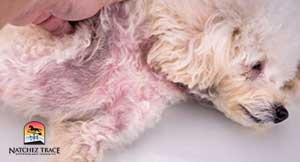 Skin Injuries or Dermatitis: Animals with existing skin injuries or dermatitis require careful consideration. The manipulations involved in Tui-na may exacerbate these conditions, leading to discomfort or potential complications. It is advisable to wait until the skin has fully healed before introducing Tui-na.
Skin Injuries or Dermatitis: Animals with existing skin injuries or dermatitis require careful consideration. The manipulations involved in Tui-na may exacerbate these conditions, leading to discomfort or potential complications. It is advisable to wait until the skin has fully healed before introducing Tui-na.- Fractures: Tui-na involves manipulating bones, muscles, tendons, and ligaments. In cases of fractures, applying pressure or movements to the affected area may worsen the condition and impede the healing process. To prevent further injury, tui-na is contraindicated in the presence of fractures.
- Phlebitis: Phlebitis (inflammation of veins) warrants caution during Tui-na treatments. Manipulating the affected area may exacerbate the inflammation and pose risks to vascular health. It is crucial to avoid Tui-na in regions with phlebitis to prevent complications.
- Infectious Disease Animals with infectious diseases should not undergo Tui-na, as the therapy’s manipulative nature may contribute to the spread of the infection. Avoiding Tui-na during active infectious episodes is essential to prioritize the health of both the animal and those in contact with it.
- Diseases Transmissible to Humans (Zoonotic/Iatrogenic) In cases where animals carry diseases that can be transmitted to humans, known as zoonotic or iatrogenic diseases, Tui-na should be approached cautiously. Proper protective measures and veterinary guidance are essential to prevent potential transmission during Tui-na treatments.

By being mindful of the above warnings and contraindications, we ensure the responsible and safe application of Tui-na, aligning with our commitment to the well-being of your cherished animal companions.
Always consult with us to assess individual cases and tailor Tui-na treatments accordingly.
Sources:
- Cvtp, S. S. D. C. (2022, July 20). Tui-na for dogs and cats. IVC Journal. https://ivcjournal.com/tui-na-for-dogs-and-cats/
- Massage and Touch (Tui-na) – Animal QI Wellness Centre. (n.d.). Animal QI Wellness Centre. https://animalqi.co.za/massage-and-touch-tui-na/
- Acupuncture.Com – QiGong / Tuina – A Brief history of Chinese therapeutic massage. (n.d.). https://www.acupuncture.com/qigong_tuina/tuinahistory.htm








